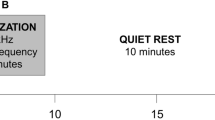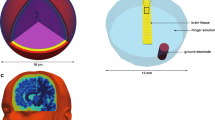Abstract
The T1 head template model used in Statistical Parametric Mapping Version 2000 (SPM2), was segmented into five layers (scalp, skull, CSF, grey and white matter) and implemented in 2 mm voxels. We designed a resistor mesh model (RMM), based on the finite volume method (FVM) to simulate the electrical properties of this head model along the three axes for each voxel. Then, we introduced four dipoles of high eccentricity (about 0.8) in this RMM, separately and simultaneously, to compute the potentials for two sets of conductivities. We used the direct cortical imaging technique (CIT) to recover the simulated dipoles, using 60 or 107 electrodes and with or without addition of Gaussian white noise (GWN). The use of realistic conductivities gave better CIT results than standard conductivities, lowering the blurring effect on scalp potentials and displaying more accurate position areas when CIT was applied to single dipoles. Simultaneous dipoles were less accurately localized, but good qualitative and stable quantitative results were obtained up to 5% noise level for 107 electrodes and up to 10% noise level for 60 electrodes, showing that a compromise must be found to optimize both the number of electrodes and the noise level. With the RMM defined in 2 mm voxels, the standard 128-electrode cap and 5% noise appears to be the upper limit providing reliable source positions when direct CIT is used. The admittance matrix defining the RMM is easy to modify so as to adapt to different conductivities. The next step will be the adaptation of individual real head T2 images to the RMM template and the introduction of anisotropy using diffusion imaging (DI).
Similar content being viewed by others
References
Babiloni F, Carducci F, Cincotti F, Del Gratta C, Roberti GM, Romani GL, Rossini PM, Babiloni C (2000) Integration of high resolution EEG and functional magnetic resonance in the study of human movement-related potentials. Methods Inf Med 39:179–182
Bayford RH, Gibson A, Tizzard A, Tidswell T, Holder DS (2001) Solving the forward problem in electrical impedance tomography for the human head using IDEAS (integrated design engineering analysis software), a finite element modelling tool. Physiol Meas 22:55–64
Baysal U, Haueisen J (2004) Use of a␣priori information in estimating tissue resistivities—application to human data in vivo. Physiol Meas 25:737–748
Chauveau N, Franceries X, Doyon B, Rigaud B, Morucci JP, Celsis P (2004) Effects of skull thickness, anisotropy, and inhomogeneity on forward EEG/ERP computations using a spherical three-dimensional resistor mesh model. Hum Brain Mapp 21:86–97
Chauveau N, Morucci JP, Franceries X, Celsis P, Rigaud B (2005a) Resistor mesh model of a spherical head: part 1: applications to scalp potential interpolation. Med Biol Eng Comput 43:694–702
Chauveau N, Morucci JP, Franceries X, Celsis P, Rigaud B (2005b) Resistor mesh model of a spherical head: part 2: a review of applications to cortical mapping. Med Biol Eng Comput 43: 703–711
Darvas F, Ermer JJ, Mosher JC, Leahy RM (2006) Generic head models for atlas-based EEG source analysis. Hum Brain Mapp 27:129–143
Ferree TC, Eriksen KJ, Tucker DM (2000) Regional head tissue conductivity estimation for improved EEG analysis. IEEE Trans Biomed Eng 47:1584–1592
Franceries X, Doyon B, Chauveau N, Rigaud B, Celsis P, Morucci JP (2003) Solution of Poisson’s equation in a volume conductor using resistor mesh models: application to event related potential imaging. J Appl Phys 93:3578–3588
Fuchs M, Kastner J, Wagner M, Hawes S, Ebersole JS (2002) A standardized boundary element method volume conductor model. Clin Neurophysiol 113:702–712
Geddes LA, Baker LE (1967) The specific resistance of biological material—a compendium of data for the biomedical engineer and physiologist. Med Biol Eng 5:271–293
Haueisen J, Ramon C, Eiselt M, Brauer H, Nowak H (1997) Influence of tissue resistivities on neuromagnetic fields and electric potentials studied with a finite element model of the head. IEEE Trans Biomed Eng 44:727–735
Haueisen J, Tuch DS, Ramon C, Schimpf PH, Wedeen VJ, George JS, Belliveau JW (2002) The influence of brain tissue anisotropy on human EEG and MEG. Neuroimage 15:159–166
He B, Wang Y, Wu D (1999) Estimating cortical potentials from scalp EEG’s in a realistically shaped inhomogeneous head model by means of the boundary element method. IEEE Trans Biomed Eng 46:1264–1268
He B, Zhang X, Lian J, Sasaki H, Wu D, Towle VL (2002) Boundary element method-based cortical potential imaging of somatosensory evoked potentials using subjects’ magnetic resonance images. Neuroimage 16:564–576
Helmholtz H (1853) Über einig Gesetze des Verteilung elektrischer Strome in Korperlischen Leitern mit Anwendung auf die tierisch-elektrischen Versuche. Ann Phys Chem 29:211–233
Latikka J, Kuurne T, Eskola H (2001) Conductivity of living intracranial tissues. Phys Med Biol 46:1611–1616
Oostendorp TF, Delbeke J, Stegeman DF (2000) The conductivity of the human skull: results of in vivo and in vitro measurements. IEEE Trans Biomed Eng 47:1487–1492
Ramon C, Schimpf PH, Haueisen J (2004) Effect of model complexity on EEG source localizations. Neurol Clin Neurophysiol 2004:81
Ramon C, Haueisen J, Schimpf PH (2006) Influence of head models on neuromagnetic fields and inverse source localizations. Biomed Eng Online 5:55
Shattuck DW, Sandor-Leahy SR, Schaper KA, Rottenberg DA, Leahy RM (2001) Magnetic resonance image tissue classification using a partial volume model. Neuroimage 13:856–876
Stok CJ (1987) The influence of model parameters on EEG/MEG single dipole source estimation. IEEE Trans Biomed Eng 34:289–296
Tikhonov VL, Arsenin VY (1977) Solutions of ill-posed problems, Wiley
Zhang Y, Brady M, Smith S (2001) Segmentation of brain MR images through a hidden Markov random field model and the expectation-maximization algorithm. IEEE Trans Med Imaging 20:45–57
Zhang X, van Drongelen W, Hecox KE, Towle VL, Frim DM, McGee AB, He B (2003) High-resolution EEG: cortical potential imaging of interictal spikes. Clin Neurophysiol 114:1963–1973
Zhang Y, van Drongelen W, He B (2006) Estimation of in vivo brain-to-skull conductivity ratio in humans. Appl Phys Lett 89:223903–2239033
Author information
Authors and Affiliations
Corresponding author
Rights and permissions
About this article
Cite this article
Chauveau, N., Franceries, X., Aubry, F. et al. Cortical Imaging on a Head Template: A Simulation Study Using a Resistor Mesh Model (RMM). Brain Topogr 21, 52–60 (2008). https://doi.org/10.1007/s10548-008-0059-0
Received:
Accepted:
Published:
Issue Date:
DOI: https://doi.org/10.1007/s10548-008-0059-0




